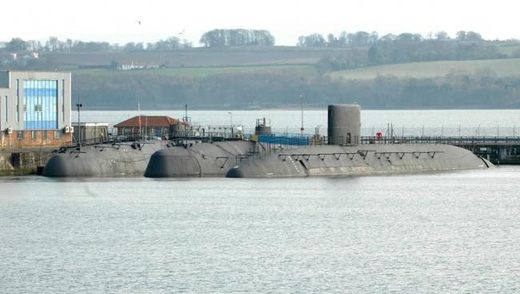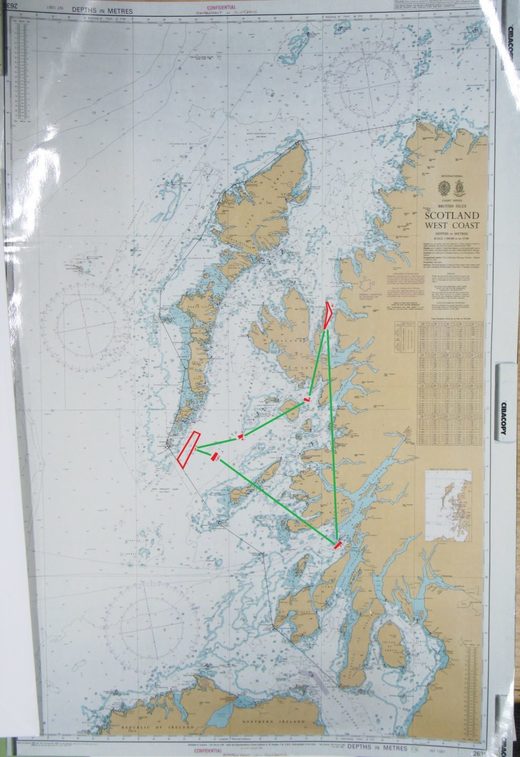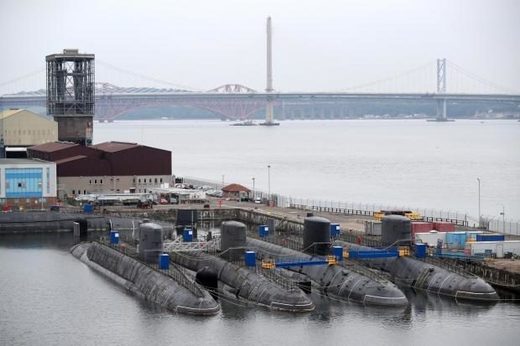Hypocrites! So the UK government can preach about “climate change” and “carbon footprints” while plotting to dump nuclear submarines in the ocean to rot…and in it’s own backyard no less? I wonder how many other nest-soiling secrets are lurking in the National Archives? Martin
Rob Edwards
TheNational.scot
Mon, 30 Dec 2018 12:00 UTC

Rosyth’s naval dockyard is home to seven defunct submarinesTHE UK Government secretly planned to dump the radioactive hulks of 22 nuclear submarines in the sea off north west Scotland, documents released by the National Archives reveal.
A survey for the Ministry of Defence (MoD) in 1989 identified six sites for “seabed storage” of defunct naval submarines near the islands of Skye, Mull and Barra for up to 60 years – and probably longer.
Detailed and highly confidential MoD studies concluded the plan was “feasible” and would “obviate the international problems which we would face were we to dispose of these vessels in international waters.”
One MoD official said the aim was “to remove submarines from public view”. Another hoped that “everyone will forget about these submarines and that they will be allowed to quietly rot away indefinitely.”

Photo of naval chart from the National Archives, with six seabed storage sites for nuclear submarines highlighted.The revelations have sparked anger and outrage from politicians and campaigners, who accused the MoD of seeing Scotland as a “nuclear dustbin”. The MoD stressed that current submarine disposal plans met the strictest standards of safety and security.
The 1989 sea-dumping plan ended up being quietly dropped. But the MoD has still not solved the problem of what to do with the accumulating number of nuclear submarines that have now been taken out of service.
Since the 1980s, seven defunct submarines have been laid up at the Rosyth naval dockyard in Fife. Since the 1990s, thirteen have been laid up at Devonport naval dockyard in Plymouth, nine of them still containing radioactive fuel.
There are a further eight nuclear submarines in service, one in overhaul and nine due to come into service at Faslane on the Clyde, including the proposed new generation of four Trident-armed submarines. That’s a total of 38 nuclear submarines that will eventually require disposal.
The MoD began a public submarine dismantling project in 2000 and announced in 2016 that a nuclear plant at Capenhurst in Cheshire had been chosen as an “interim storage site” for radioactive waste. Storing the waste at Chapelcross in south west Scotland was rejected after objections from the Scottish Government.
Work on dismantling the first “demonstrator” submarine, Swiftsure, began at Rosyth (pictured below) in 2016. The MoD said in December 2018 that over 70 tonnes of radioactive and non-radioactive waste had been removed, and that dismantling of a second submarine, Resolution, would start in 2019.

But it was the problem of what to do with the first nuclear submarine to be decommissioned that was secretly exercising ministers and officials in 1989. Dreadnought had been taken out of service in 1980, and was berthed at Rosyth.
Documents recently unveiled at the National Archives in London show that the initial plan – also kept secret at the time – was to dump Dreadnought in international waters out in the north east Atlantic. But this had to be abandoned because of fierce US and international opposition.
“Sea disposal would provoke considerable international controversy,” said an internal MoD report in October 1988. “Britain would be isolated internationally.”
So instead the MoD came up with the idea of “seabed storage” of an envisaged 22 submarines for between 20 and 60 years. Experts said that potential sites had to be outwith shipping lanes, too deep to be reached by recreational divers and within sight of land so that attempts by Russians to access submarines would be visible.
A MEMO in February 1989 suggested that access to the dumping sites would be restricted. “A permanently prohibited area could be established and, if necessary, marked by buoys,” it said. “At the very least a fishing and anchorage prohibited area would be required.”
A hydrographic survey for the MoD mapped six possible sites, all along the north west coast of Scotland. One was to the north of the Isle of Skye near Raasay and one to the south near Rum.
One site was between the islands of Mull and Jura and another just south east of Barra. Two sites were in the Sea of the Hebrides between Barra, Tiree and Coll. The plan was to seal the submarines, tow them from Rosyth and sink them on to the seabed. In February 1989 an MoD official reminded colleagues that Dreadnought had been boycotted by trade unionists at the dockyard so “they should be prepared for some PR work”.
Several officials warned of the difficulties of retrieving submarines from the seabed after 60 years. There was “profound uncertainty” over what condition they would be in, cautioned the MoD’s PJH Evans on 13 March 1989.
“The public relations aspect of recovering a rusty hulk should also be borne in mind,” he said. “I imagine the highest hope must be that everyone will forget about these submarines and that they will be allowed to quietly rot away indefinitely.”
In a seeming afterthought, Evans crossed out the word “highest” by hand on the printed document and replaced it with “pious”.
Three days later another official, PH Briscoe, described the reason for seabed storage as “to remove submarines from public view/concern” and “to allow time (60 years!) to decide on a permanent method of disposal for the reactor.”
The archive documents were accessed and photographed by the veteran nuclear researcher, Brian Burnell. “It is extraordinary to realise that the MoD was seriously considering sinking old nuclear submarines onto the seabed near Scotland less than 30 years ago,” he said.
“If the top-secret plans had got out at the time there would have been outrage so it’s no wonder they were desperate to keep it quiet. The hope of some within the MoD was that scuttling the submarines would mean that they were out of sight and out of mind, and could eventually just be abandoned.”
The SNP MP for Dunfermline and West Fife, Douglas Chapman, argued that the MoD had little idea what to do with its radioactive debris. “These released papers simply highlight the arrogant and contemptuous approach to disposal of their nuclear waste.
“They think that Scotland can be used as some sort of convenient nuclear dustbin. We’ve seen this with MoD dumping of munitions in the Solway Firth and radioactive materials at Dalgety Bay.”
Friends of the Earth Scotland suggested that the MoD had failed to learn from previous mistakes. “Instead they came up with this crazy plan to endanger the environment and the livelihoods of the whole of the west of Scotland,” said its director, Dr Richard Dixon.
“In this desperate out of sight, out of mind strategy, the first we would have known that one of the reactors was leaking would have been when large parts of the coast became contaminated. This kind of plan would have been completely unacceptable in the Cold War scramble of the 1950s – it is staggering that it was seriously considered in the 1980s.”
According to Jane Tallents, a former advisor to the MoD’s submarine dismantling project, the Scottish sea-dumping plans weren’t mentioned in years of public consultations. “Towing these great hulks out to sink them couldn’t possibly stay secret for long and the idea that people would just forget about them was wishful thinking,” she said.
The Scottish Campaign for Nuclear Disarmament described the MoD plan as “gob-smacking” and “madcap”. It showed “complete disregard” for the health and safety of people in north west Scotland, said campaign chair, Arthur West.
The released documents do not make clear why the plan was dropped. “As with any issue, a range of proposals would have been given to the government of the day to inform their decision-making,” an MoD spokesperson told The Ferret.
“This option was discounted in favour of our current methodology of disposing submarines, which meets the strictest standards of safety and security.”
The Ferret is an editorially independent, not-for-profit co-operative run by its journalists and subscribers. You can find it at https://theferret.scot/ and can subscribe for £3 a month here: https://theferret.scot/subscribe/
Sourced from SOTT








